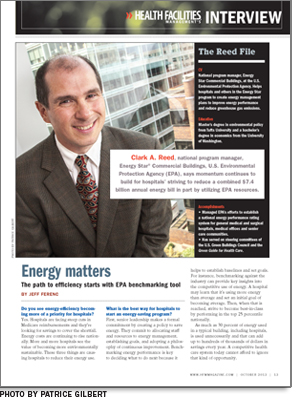
Clark A. Reed, national program manager, Energy Star® Commercial Buildings, U.S. Environmental Protection Agency (EPA), says momentum continues to build for hospitals' striving to reduce a combined $7.4 billion annual energy bill in part by utilizing EPA resources.
Do you see energy-efficiency becoming more of a priority for hospitals?
Yes. Hospitals are facing steep cuts in Medicare reimbursements and they're looking for savings to cover the shortfall. Energy costs are continuing to rise nationally. More and more hospitals see the value of becoming more environmentally sustainable. These three things are causing hospitals to reduce their energy use.
What is the best way for hospitals to start an energy-saving program?
First, senior leadership makes a formal commitment by creating a policy to save energy. They commit to allocating staff and resources to energy management, establishing goals, and adopting a philosophy of continuous improvement. Benchmarking energy performance is key to deciding what to do next because it helps to establish baselines and set goals. For instance, benchmarking against the industry can provide key insights into the competitive use of energy. A hospital may learn that it's using more energy than average and set an initial goal of becoming average. Then, when that is reached, strive to become best-in-class by performing in the top 25 percentile nationally.
As much as 30 percent of energy used in a typical building, including hospitals, is used unnecessarily and that can add up to hundreds of thousands of dollars in savings every year. A competitive health care system today cannot afford to ignore that kind of opportunity.
Which hospitals stand out as being energy-efficient?
There are a number of health care systems that are doing great work to reduce energy consumption and greenhouse gas emissions. Two that stood out to us in the past year are Memorial Hermann and the Air Force Medical Support Agency, both headquartered in Texas. Over the past four years, Memorial Hermann achieved an average Energy Star score of 66 across its portfolio, representing a 29-point improvement since 2008, and yielding an $11.8 million improvement to their bottom line.
The Air Force increased its portfolio–wide average Energy Star score by 10 points last year, reducing its average energy use intensity by 104 kBtu per square foot, and achieving more than $3 million in energy cost savings. For these accomplishments, EPA named both health care systems our 2013 Energy Star Partner of the Year.
What do you see as the best opportunities for hospitals to become more energy-efficient?
It doesn't take a lot of money to start saving energy. Retrocommissioning is where many hospitals begin to cut energy, because it's a very cost-effective way to demonstrate quick energy savings to senior leadership. Over time, it's natural for building systems to fall out of calibration, malfunction or operate unnecessarily because of occupancy changes.
Retrocommissioning identifies improper equipment performance and brings them back into efficient operation. Retrocommissioning often can result in a 10 percent or more reduction in energy use and increase the life of equipment.
How else can hospitals save energy?
I think the market is improving for all types of equipment, but lighting is continuing to make very impressive advancements in terms of quality and efficiency. For example, manufacturers are introducing even more efficient LEDs than those on the market and they're enabling them to be used in any fixture, any orientation, in any location.
Behavior change is another opportunity that often is overlooked in energy management but, for those who do it, another 10 percent energy savings on average is possible. These organizations foster an understanding that everyone, not just the facility operations team, is responsible for reducing energy waste. So lights get turned off when people leave a room, computers get turned off at the end of the day.
The Cleveland Clinic credits more than 10 percent of its energy savings to behavior change. Green teams consisting of staff from all levels of the hospital help to identify energy waste. Even nurses on their daily patient rounds call facility operations to take corrective action.
How can hospital leaders help to sustain energy management programs?
Have senior leadership put a formal energy policy in writing and designate an energy director for the organization that tells everybody that energy management is not something that's going to disappear from the radar.
When energy management is incorporated into monthly, quarterly and annual reports — when people are given incentives or part of their performance is evaluated based on energy — then it becomes embedded in the organization. Once energy management becomes institutionalized, savings can begin to happen.
How does the Portfolio Manager® benchmarking program help hospitals to improve their energy-efficiency?
You can't manage what you don't measure. Benchmarking a facility's energy use with Portfolio Manager gives hospitals the information they need to drive energy-efficiency and create value.
Once a health care system has benchmarked, then it can prioritize projects strategically, focus on investments and work on improvement. In short, Portfolio Manager helps to illuminate the path toward improvement.
I think one of the benefits of benchmarking in Portfolio Manager is the ability to get a portfoliowide snapshot of the performance of your buildings. For example, how do the hospitals in your portfolio compare with one another? Why does one perform with half the efficiency as all the rest? How do hospitals compare with similar facilities across the country? Why is most of the portfolio below average in terms of energy-efficiency?
To receive an Energy Star score, Portfolio Manager requires a year's worth of energy consumption data, and key operational characteristics like gross square footage and the number of operational beds. The 100-point scale compares a hospital's energy performance with its peer group nationally, with 50 as the national median, while normalizing for weather and operations and other building characteristics.
Energy Star just upgraded Portfolio Manager with enhanced graphics, improved sharing functions and more custom templates. Create your own private secure account within Portfolio Manager free of charge at www.energystar.gov/benchmark and begin collecting data and benchmarking.
Do you see momentum continuing for hospitals' working at saving energy?
Our latest figures show that more than 4,800 hospitals have received Energy Star scores. Of course, benchmarking is only the first step to saving energy, but the fact that we're seeing such robust benchmarking numbers indicates that hospitals are placing greater emphasis on reducing energy use.
Over the past 20 years of this program, we have seen hospital partners make dramatic energy savings over a short period, not because they employed some advanced technology, but because they took the time to work out a plan, gain internal support and took a systematic approach to saving energy.
When they realize how quickly they can get 10 and even 20 percent energy savings, it becomes almost a game, an obsession even, because their bottom line and our environment benefit. And that's what this voluntary program is all about — a win on all fronts.
Jeff Ferenc is senior editor for Health Facilities Management.
| Sidebar - The Reed File |
| CV National program manager, Energy Star Commercial Buildings, at the U.S. Environmental Protection Agency. Helps hospitals and others in the Energy Star program to create energy management plans to improve energy performance and reduce greenhouse gas emissions. Education Master's degree in environmental policy from Tufts University and a bachelor's degree in economics from the University of Washington. Accomplishments
|





